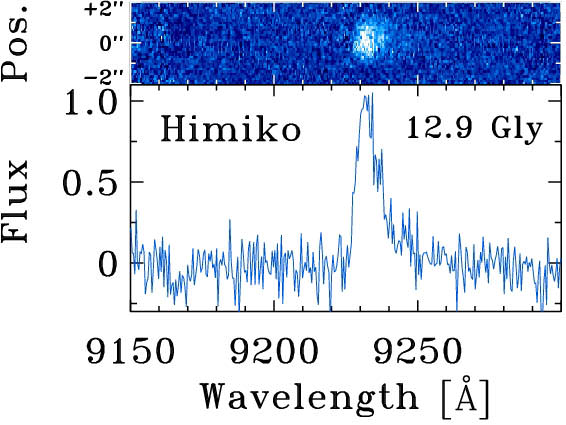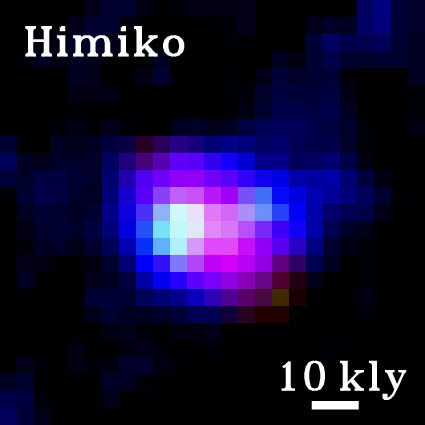[/caption]
This mysterious, giant object existed at a time when the universe was only about 800 million years old. It stretches for 55 thousand light years, a record for that early point in time. Its length is comparable to the radius of the Milky Way’s disk.
Besides being a great candidate for a future “Where in the Universe Challenge,” what is it?

In general, objects such as this one are dubbed extended Lyman-Alpha blobs; they are huge bodies of gas that may be precursors to galaxies.
And this blob was named Himiko for a legendary, mysterious Japanese queen.
Beyond that, researchers remain puzzled. It could be ionized gas powered by a super-massive black hole; a primordial galaxy with large gas accretion; a collision of two large young galaxies; super wind from intensive star formation; or a single giant galaxy with a large mass of about 40 billion Suns. Because this mysterious and remarkable object was discovered early in the history of the universe in a Japanese Subaru field, the researchers named the object after the legendary, mysterious queen.
“The farther out we look into space, the farther we go back in time, ” explained lead author Masami Ouchi, a fellow at the Observatories of the Carnegie Institution who led an international team of astronomers from the United States, Japan and the United Kingdom. “I am very surprised by this discovery. I have never imagined that such a large object could exist at this early stage of the universe’s history.”
Ouchi adds that, according to Big Bang cosmology, small objects form first and then merge to produce larger systems. “This blob had a size of typical present-day galaxies when the age of the universe was about 800 million years old, only 6 percent of the age of today’s universe,” he said.
Extended blobs discovered before now have mostly been seen at a distance when the universe was 2 to 3 billion years old. No extended blobs have previously been found when the universe was younger. Himiko is located at a transition point in the evolution of the universe called the reionization epoch—it’s as far back as we can see to date. And at 55 thousand light years, Himiko is a big blob for that time.
This reionizing chapter in the universe was at the cosmic dawn, the epoch between about 200 million and one billion years after the Big Bang. During this period, neutral hydrogen began to form quasars, stars, and the first galaxies. Astronomers probe this era by searching for characteristic hydrogen signatures from the scattering of photons created by ionized gas clouds.
The team initially identified Himiko among 207 distant galaxy candidates seen at optical wavelengths using the Subaru telescope from the Subaru/XMM-Newton Deep Survey Field located in the constellation of Cetus. They then made spectroscopic observations to measure the distance with the Keck/DEIMOS and Carnegie’s Magellan/IMACS instrumentation.
Himiko was an extraordinarily bright and large candidate for a distant galaxy.
“We hesitated to spend our precious telescope time by taking spectra of this weird candidate. We never believed that this bright and large source was a real distant object. We thought it was a foreground interloper contaminating our galaxy sample,” said Ouchi. “But we tried anyway. Then, the spectra exhibited a characteristic hydrogen signature clearly indicating a remarkably large distance—12.9 billion light years!”
Using infrared data from NASA’s Spitzer Space Telescope and the United Kingdom Infrared Telescope, radio data from the VLA, and X-ray imaging from the XMM-Newton satellite, Ouchi and his colleagues have been able to estimate the star-formation rate and stellar mass of the galaxy and to search for an active nucleus powered by a super-massive black hole.
“We found that the stellar mass of Himiko is an order of magnitude larger than other objects known at a similar epoch, but we cannot as yet tell if the center houses an active and growing black hole,” said James Dunlop, a team member from the University of Edinburgh.
Alan Dressler, a team member from the Carnegie Institution, said it’s possible that Himiko is a member of a whole class of objects yet to be discovered.
“Because this object is, to this point, one-of-a-kind, it makes it very hard to fit it into the prevailing model of how normal galaxies were assembled. On the other hand, that’s what makes it interesting,” he said.
Source: Carnegie Institution. The research appears in the May 10, 2009, issue of The Astrophysical Journal (here).


Thanks, Anne, for this story of these extremely distant LABs. There seems to be a growing amount of literature on these objects, so the link to the paper was much appreciated. Perhaps the IR eye of the James Webb Space Telescope will have the resolution and sensitivity to answer questions of their nature and structure. I had already read the paper referenced in the story. Interesting that the researchers nicknamed the object Himiko which is “the name of legendary queen in ancient Japan”. Sure is a lot easier to remember than the coordinate-based designation is!
Redshift is z=6.595 – for the real astronomers… 😉
Not sure if this is a silly question – but ….
When the universe was very young – much smaller than it is today and with a far greater mass density… was the gravitational gradient across the universe far greater than it is today?
And if it was – would this have caused relativistic effects at the time – in particular extreme time dilation? Does these effect (if it exists) affect our measurements of the red shift from ancient light such as that from Himiko? Would extreme time dilation in the early universe affect our measurement of the age of the universe?
Apologies if I’m right off the mark with this one 😉
This is going waaaaay back into my memory banks a little bit, but I’ll takea stab at answering your question, UKDave. The object in this image is being seen as it was when the Universe was only 800 billion years old. It certainly was smaller then, but I don’t think it was small enough for gravitationally-induced time dilation to occur in any measurable degree.
Also, back in the epoch of the Universe when it *was* small enough for the density of energy and matter to create enough gravity to possibly induce a sizable time dilation effect, the distribution of matter was very uniform and created what I think was called a “false vacuum”. Anyone who would be unlucky enough to have been around in that era would probably still feel “weightless” because all the matter would be pulling on him/her more or less uniformly in all directions (sort of like being at the center of the Earth).
There is an error with this report. This object is further out than 12.9 light years. Nothing travels faster than light, but a spatial manifold can expand so that points separate at speed much faster than light. The CMB blackground radiation as a result occurs some 51 billion light years out. It is also the case that photons from these objects do reach us as well. Check out Ned Wright’s website for details on this.
Lawrence B. Crowell
It is remarkable what we can do these days. There are people alive today (in their 90s) who were born in a time when people believed that the Universe didn’t stretch any further than the edge of the Milky Way.
Now we’re being treated with almost weekly discoveries of objects on the other side of the visible universe, almost 13 billion light years away.
Sometimes it’s worth taking a step back and remembering that!
It is just another active galaxy.
No one seems to have noticed that in an epoch when the universe is supposed to be in its early stage of development, then the density of objects must also reflect that density…. oooooppps!
At that early epoch, that object should be surrounded by the rest of the universe in the early stages of expansion……. oooopppps again!
Sorry everyone, just could not resist the jibe.
The huge Himiko blob: Masami Ouchi says:
I have never imagined that such a large object could exist at this early stage of the universe’s history.”
Extended blobs discovered before now have mostly been seen at a distance when the universe was 2 to 3 billion years old
The spectra exhibited a characteristic hydrogen signature clearly indicating a remarkably large distance—12.9 billion light years!”
Suggestions made by Masami Ouchi and his team:
It could be:
1: Ionized gas powered by a super-massive black hole.
2: A primordial galaxy with large gas accretion
I would suggest that this is an example that the common Big Bang theory is wrong.
Conclusion if (1) is right, then the big bang spewed not only a primordial gas cloud but more important lots of massive black holes!! Which accelerated the (unresolved) fast formation of galaxies in the universe.
The CPT symmetric multiverse by Black hole evaporation
http://bigbang-entanglement.blogspot.com/2007/03/backreaction-lee-smolins-trouble-with.html
“It is remarkable what we can do these days. There are people alive today (in their 90s) who were born in a time when people believed that the Universe didn’t stretch any further than the edge of the Milky Way.”
And just think that only 8000 years ago most of the humanity still ‘was having fun playing with sticks and stones’. Considering that the universe needed 800 milion years to form a blob of gas.. wow, we really achieved something.
The mature galaxies found in the Hubble Ultra Deep Space Images were blobs in the Hubble Deep Space images. More resolution is required before assigning attributes to an object that is much larger-than-predicted by theory. If it is too big; We don’t have theoretical constraints on what it is.
The question of why the big bang did not produce black holes is related to the issue of why the entropy of the universe at the big bang was so low. The initial entropy of the universe prior to inflation was ~ few E_p/k, for E_p the Planck energy and k the Boltzmann constant. I have a paper in review on this, which involves how an AdS spacetime “patch” tunnels out of the vacuum state configuration with a near extremal Reissnor Nordstrom black hole.
Lawrence B. Crowell
Reshift = distance is the fundamental flaw in reasoning here.
These blobs are in fact nearby objects, where the mass of electrons is much less than those on earth giving rose to a spectral shift in lines that cannot be assumed to be doppler shift.
These blobs are in fact quasars seen up close
.
No, that is wrong. In fact as Pauli might put it, it is not even wrong.
L. C.
@michael
I think you’re right. The question is how far away is it really? Examining a wider field of surrounding objects might provide some clues. After reading the paper, it seems to be a quasar in the process of maturing into an AGN. The spectrum lies somewhere between a quasar and an AGN, there is at least one axial jet and obvious rotation. Indications of a halo, disc and star forming. That’s not based on visuals alone, it’s in the raw data. Being closer, smaller and dimmer makes it appear to be huge and massive when looking at it as being nearly 13 billion ly away. It’s probably no more than 2 or 3 billion ly away.